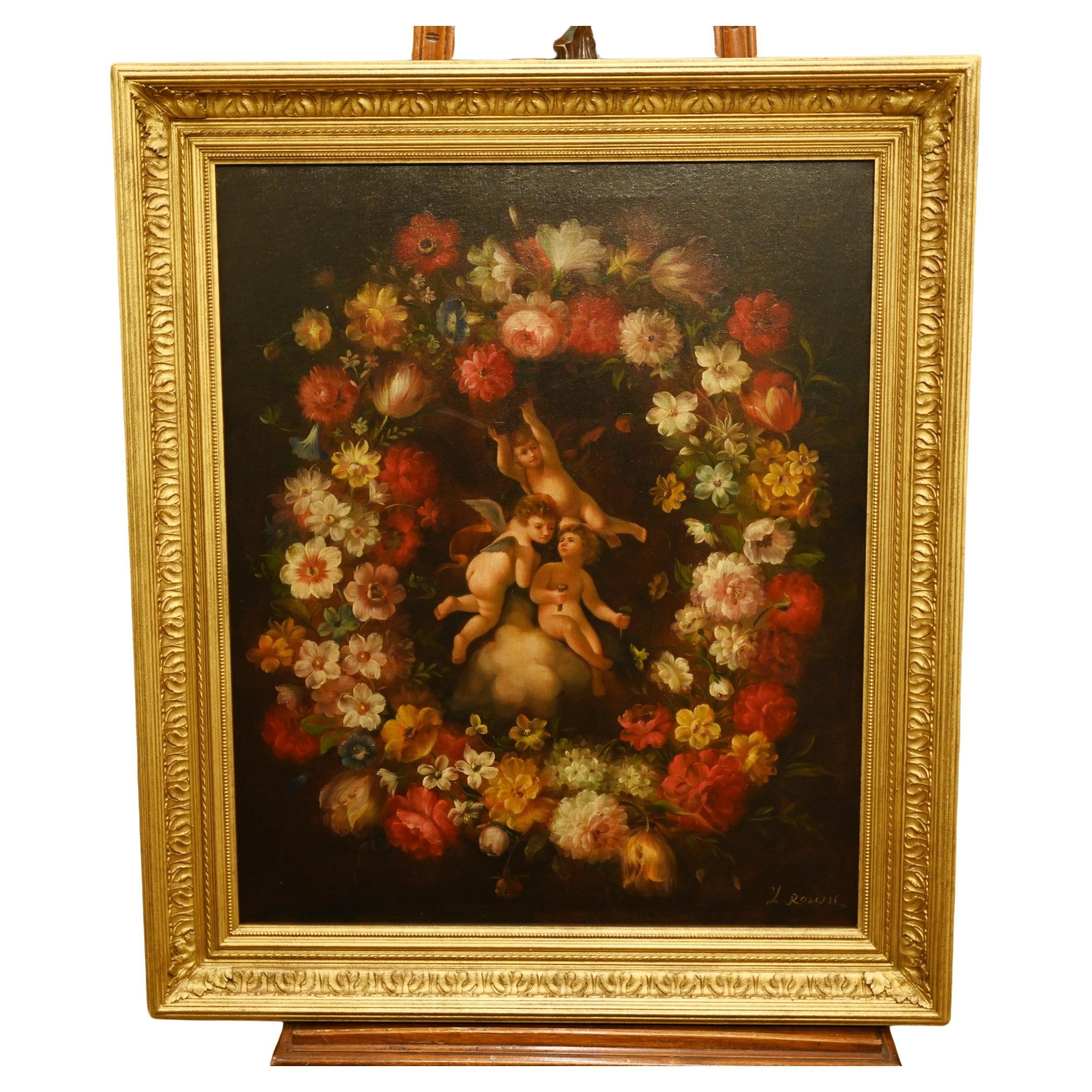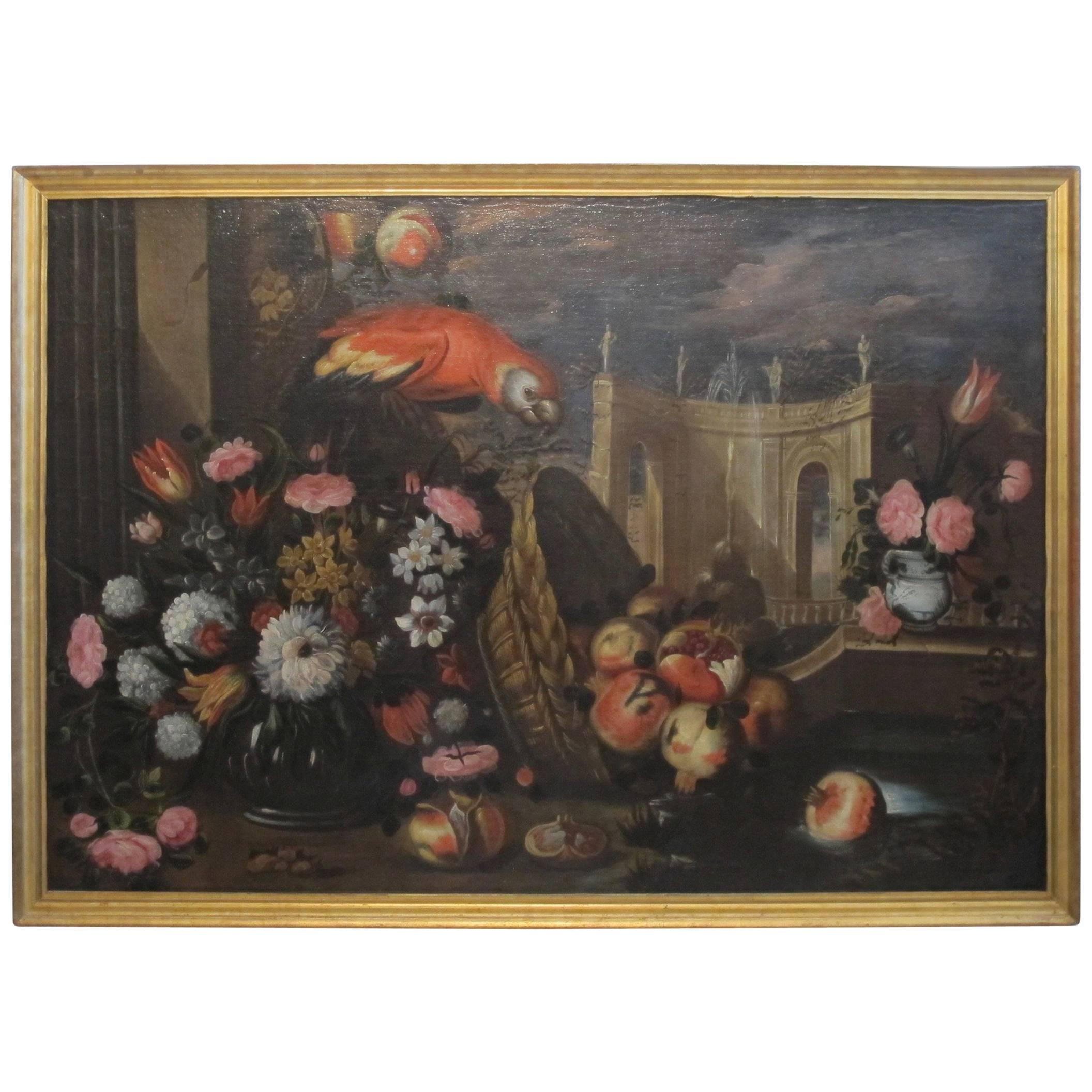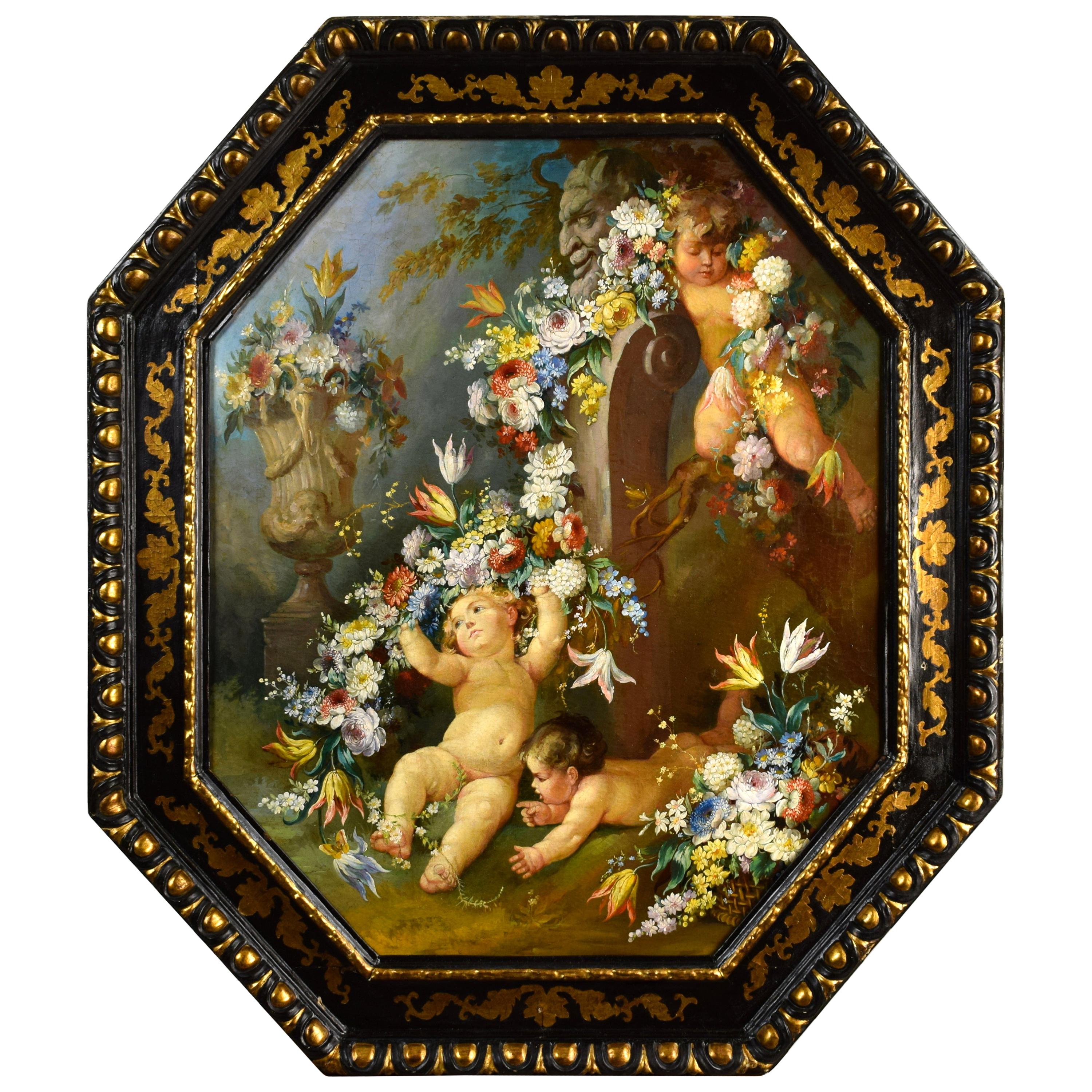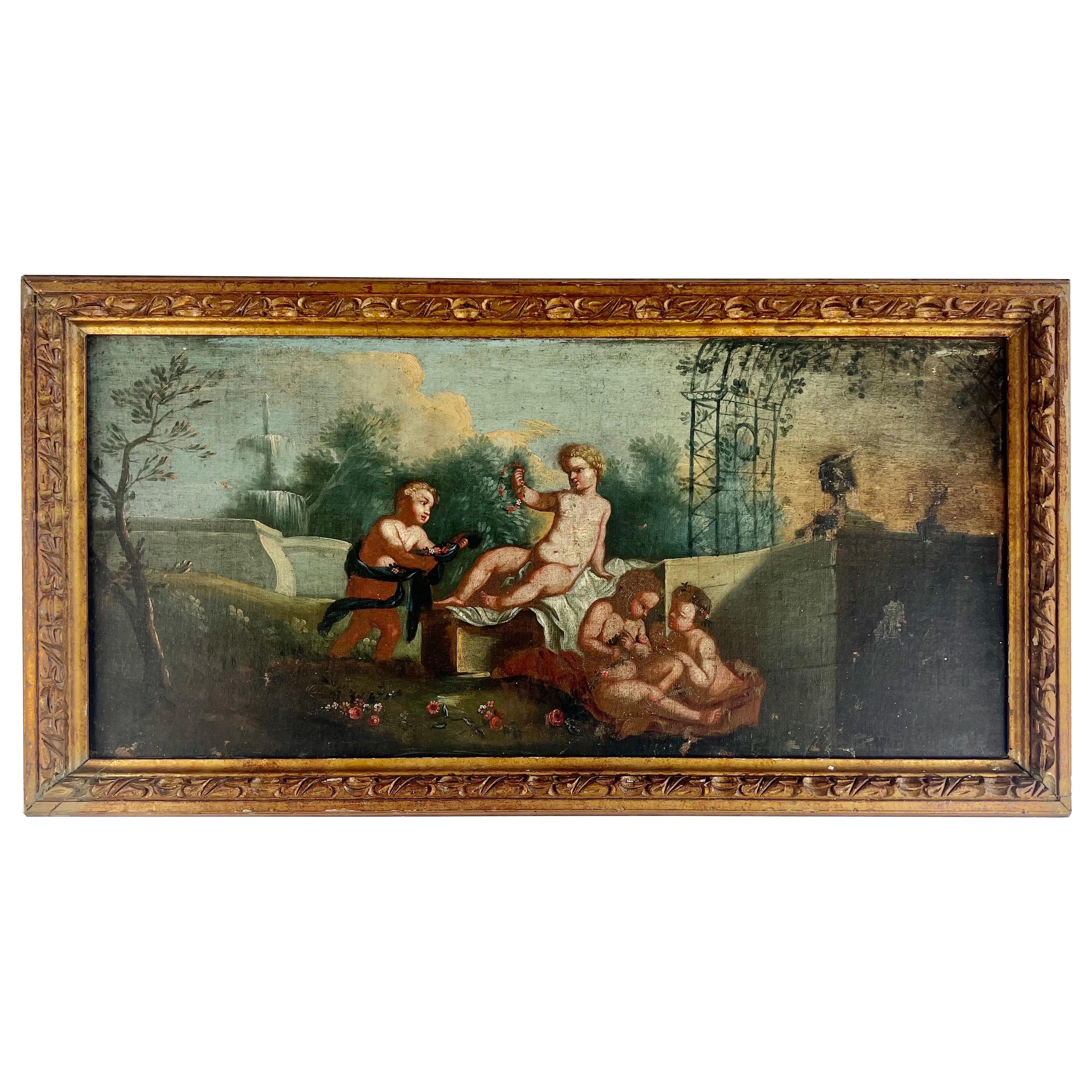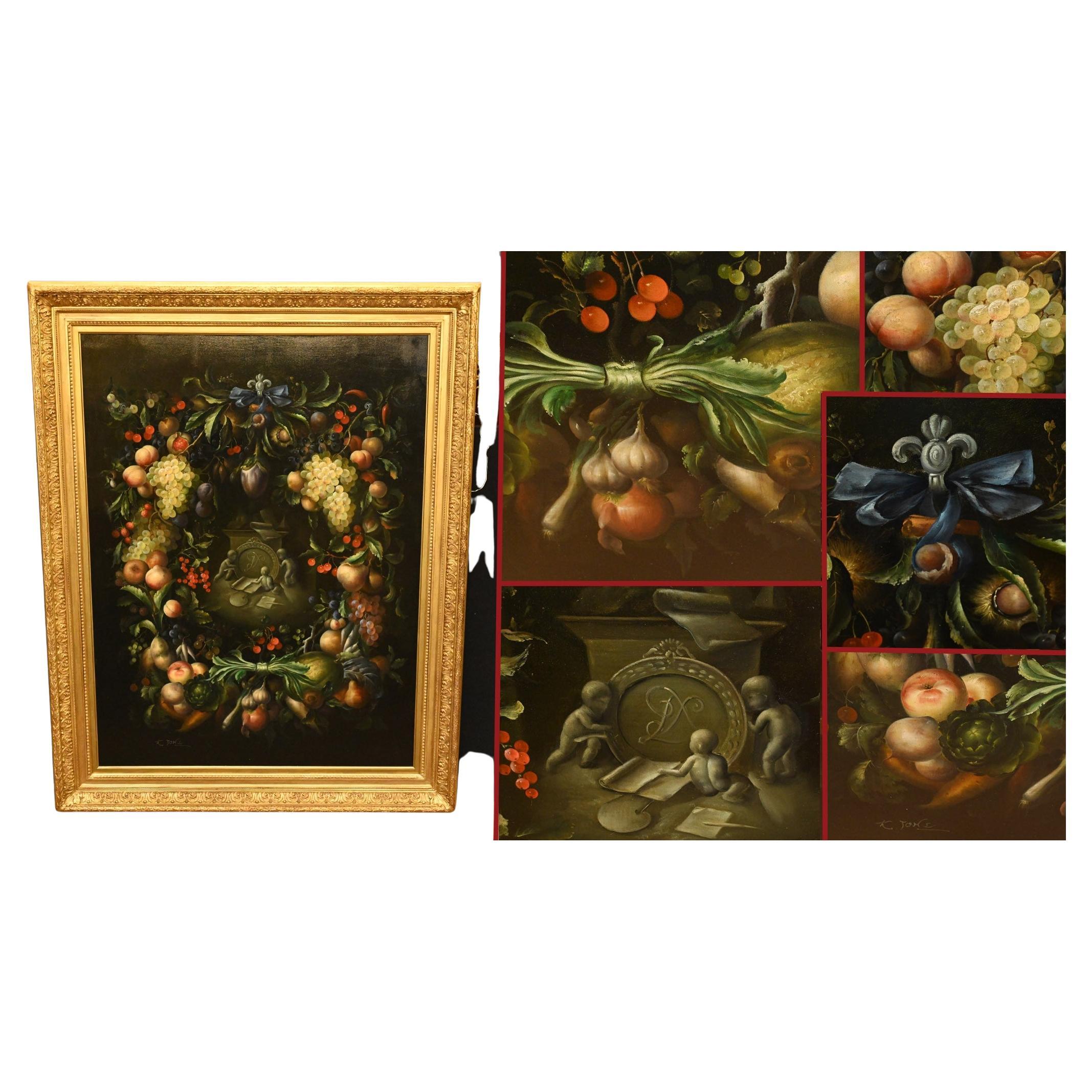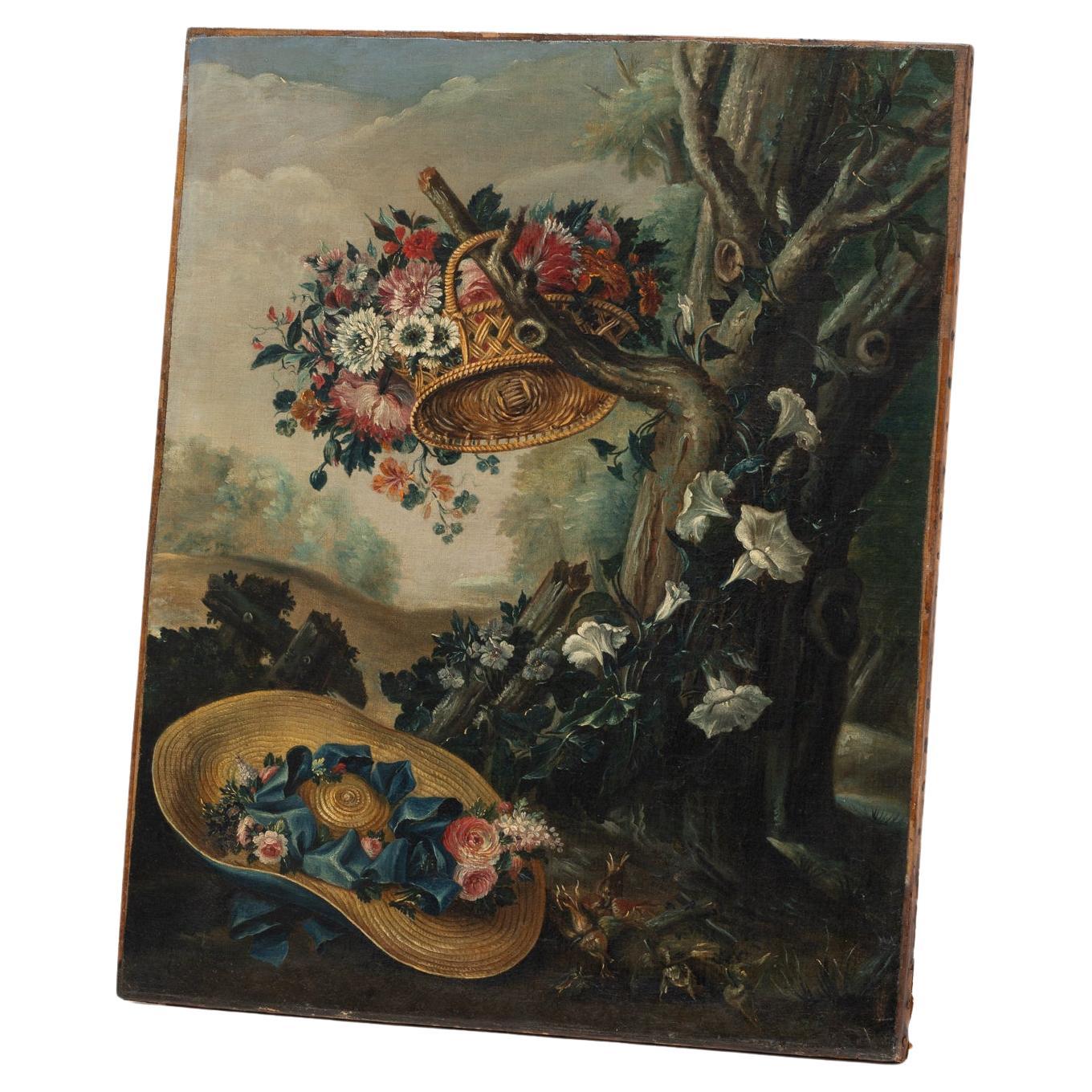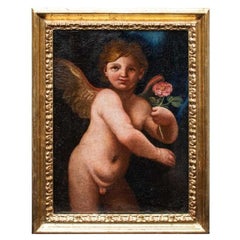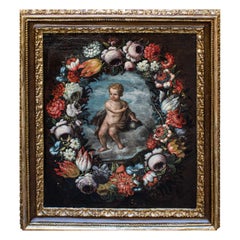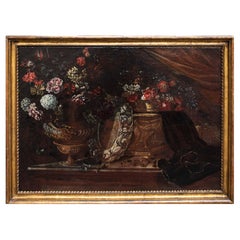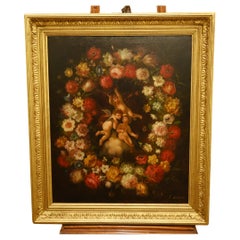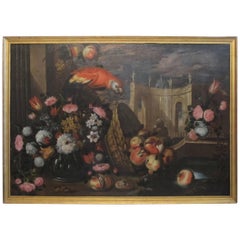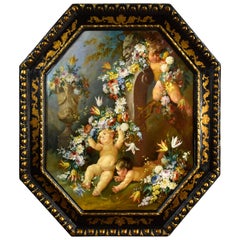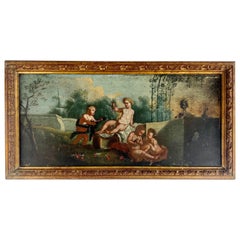Items Similar to 18th Century Parrot with Cherubs and Flowers Painting Oil on Canvas by Reneman
Want more images or videos?
Request additional images or videos from the seller
1 of 7
18th Century Parrot with Cherubs and Flowers Painting Oil on Canvas by Reneman
$5,270.06
£3,905.40
€4,400
CA$7,194.63
A$8,003.73
CHF 4,195.65
MX$97,803.60
NOK 53,426.42
SEK 50,293.59
DKK 33,501.21
Shipping
Retrieving quote...The 1stDibs Promise:
Authenticity Guarantee,
Money-Back Guarantee,
24-Hour Cancellation
About the Item
I. Reneman (Netherlands, active in the second half of the 18th century)
Parrot with cherubs and flowers
Oil on canvas, 100.5 x 84.5 cm
Signed on the base “I. Reneman fecit "
The painting depicts a still life of vivid splendor: within a niche there is a marble sculpture with cherubs and a rooster around which, with extreme grace, plant racemes with violets intersect, following the trend of the arms of the two children. striped tulips, red carnations and various species of roses. Small butterflies fly and rest on the flowers. An elegant parrot then rests next to the base, holding a claw resting on a pomegranate fruit and turning its head back towards the statues. The warning gesture of the standing child, who reaches out towards the bird with his arm pointing upwards, seems to be aimed at the animal, caught in the act while stealing the grains of the fruit with its paws, giving proof of the pictorial inspiration of the artist who infuses the canvas with realism and liveliness. Even the lying putto turns his gaze to the animal, but in a much more placid and almost disinterested attitude than his companion. The pictorial touch and the use of bright colors for the rendering of the flowers, from the intense violet of the violets to the carmine red of the carnations and the pastel shades of the roses, lights up the composition and makes it extremely real and alive. In particular, we note the contrast with the glossy patina that covers the marble sculpture, capable of reflecting the ray of light coming from above and emphasizing the fleshy bodies of the two plump children, the flowers and fruits on the base. Finally, the insertion of the parrot, with the brightly colored mantle, contrasts with the static nature of the two sculptures. The pictorial touch and the use of bright colors for the rendering of the flowers, from the intense violet of the violets to the carmine red of the carnations and the pastel shades of the roses, lights up the composition and makes it extremely real and alive. In particular, we note the contrast with the glossy patina that covers the marble sculpture, capable of reflecting the ray of light coming from above and emphasizing the fleshy bodies of the two plump children, the flowers and fruits on the base. Finally, the insertion of the parrot, with the brightly colored mantle, contrasts with the static nature of the two sculptures. The pictorial touch and the use of bright colors for the rendering of the flowers, from the intense violet of the violets to the carmine red of the carnations and the pastel shades of the roses, lights up the composition and makes it extremely real and alive. In particular, we note the contrast with the glossy patina that covers the marble sculpture, capable of reflecting the ray of light coming from above and emphasizing the fleshy bodies of the two plump children, the flowers and fruits on the base. Finally, the insertion of the parrot, with the brightly colored mantle, contrasts with the static nature of the two sculptures. we note the contrast with the glossy patina that covers the marble sculpture, capable of reflecting the ray of light coming from above and emphasizing the fleshy bodies of the two plump children, the flowers and fruits on the base. Finally, the insertion of the parrot, with the brightly colored mantle, contrasts with the static nature of the two sculptures. we note the contrast with the glossy patina that covers the marble sculpture, capable of reflecting the ray of light coming from above and emphasizing the fleshy bodies of the two plump children, the flowers and fruits on the base. Finally, the insertion of the parrot, with the brightly colored mantle, contrasts with the static nature of the two sculptures.
The signature on the base bears the writing “I. Reneman fecit ”, Dutch painter active, according to genealogical sources, around 1772.
- Dimensions:Height: 39.57 in (100.5 cm)Width: 33.27 in (84.5 cm)Depth: 1.58 in (4 cm)
- Materials and Techniques:
- Place of Origin:
- Period:
- Date of Manufacture:18th Century
- Condition:Refinished. Wear consistent with age and use. The painting has been cleaned.
- Seller Location:Milan, IT
- Reference Number:1stDibs: LU5918226733952
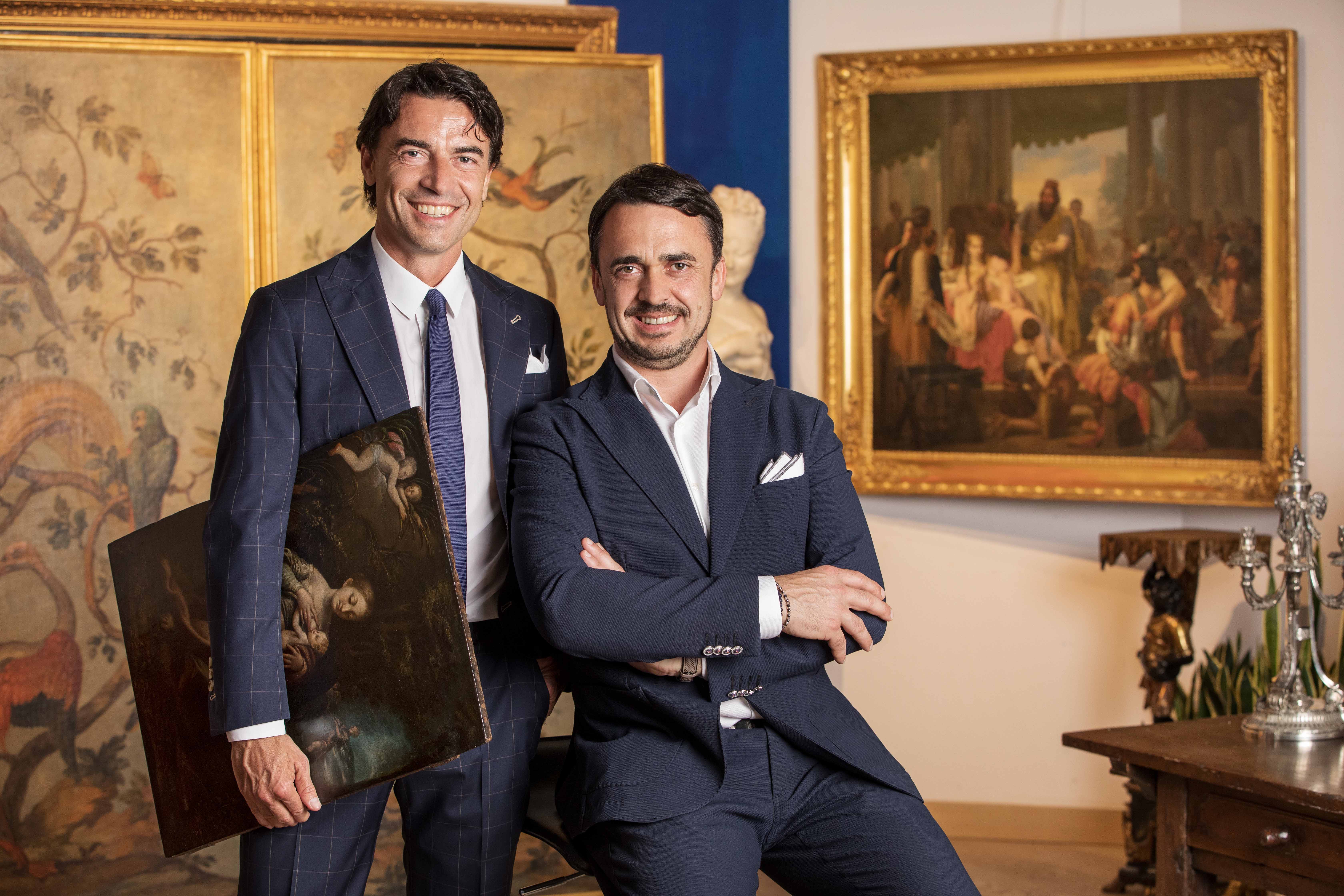
About the Seller
5.0
Vetted Professional Seller
Every seller passes strict standards for authenticity and reliability
Established in 2000
1stDibs seller since 2021
30 sales on 1stDibs
- ShippingRetrieving quote...Shipping from: Milan, Italy
- Return Policy
Authenticity Guarantee
In the unlikely event there’s an issue with an item’s authenticity, contact us within 1 year for a full refund. DetailsMoney-Back Guarantee
If your item is not as described, is damaged in transit, or does not arrive, contact us within 7 days for a full refund. Details24-Hour Cancellation
You have a 24-hour grace period in which to reconsider your purchase, with no questions asked.Vetted Professional Sellers
Our world-class sellers must adhere to strict standards for service and quality, maintaining the integrity of our listings.Price-Match Guarantee
If you find that a seller listed the same item for a lower price elsewhere, we’ll match it.Trusted Global Delivery
Our best-in-class carrier network provides specialized shipping options worldwide, including custom delivery.More From This Seller
View All17th Century Putto with Rose Painting Oil on Canvas Emilian School
Located in Milan, IT
Emilian school, 17th century
Putto with rose
Oil on canvas, 43.5 x 32 cm - with frame 45 x 32.5 cm
The figure of the putto, when equipped with specific attributes, lends it...
Category
Antique 17th Century Italian Paintings
Materials
Canvas
Oil on canvas Jesus child within garland of flowers 18th century
Located in Milan, IT
Lombard School, 17th century
Christ child with globe within garland of flowers
Oil on canvas, 72 x 61 cm
Framed 90, 5 x 80
The present painting, framed by a sumptuous antique fr...
Category
Antique 18th Century Paintings
Materials
Canvas
19th Century Still Life with Fruits Painting Oil on Canvas
Located in Milan, IT
Nineteenth century.
Still life with fruits.
Oil on canvas, 64 x 52 cm.
The still life analyzed presents a mixture of floral and fruit elements arranged in a circular order o...
Category
Antique 19th Century Italian Paintings
Materials
Canvas
Oil painting on canvas depicting Still life Roman school of the 17th century
Located in Milan, IT
Roman School, 17th century
Still Life
Oil on canvas, 79 x 107 cm
Framed, 93 x 121 cm
The work under scrutiny, depicting a majestic still life of flowers, is ascribed to the 17th...
Category
Antique 17th Century Paintings
Materials
Canvas
18th Century Cherub Head Sketch Painting Oil on Canvas
Located in Milan, IT
Venetian school, 18th century
Study with the head of a cherub
Measures: Oil on canvas, 45.5 x 41 cm - with frame 54.5 x 49.5 cm
The present qualifies as a study or preparatory sketch by virtue of the structural and figural layout; by reason of formal and substantial evidence, it can be traced back to the mature neo-Venetian style, which in the eighteenth century had begun to produce figurations of extreme typological pathetism and formal expressionism. The contemporary painting experience of Tiepolo commanded the Venetian art scene, once the lesson of Pier Francesco Mola (1612-1666) was overruled.
The delicate putto head offered here, in which a cherub is recognizable due to the happy iconographic solution of the wings placed under the angel's face, is outlined with a vigorous vitalism. A foreshortened point of view illuminates his face in a grazing way, probing his features with strong shadows and with a youthful blush that orange his cheeks. The veristic perfection with which the artist arranges the semblant is of marvelous expressiveness. The eyes are swollen with intensity, and together with the general setting of the head they denounce a conscious reflection on the physiognomy, peculiar within the emerging context of Venetian painting.
The painting in question is affected by the large-scale productions, both monumental and perspective, at the time in vogue in the territory of the Serenissima. Conceived through a vision from below, the portrait reveals from the Venetian Rococo that particular predilection for the open and clear, airy ways, denounced in the first instance by Tiepolo. The conscious detachment from the Cortona-style decorativism and from the repeated layout solutions then in vogue allow us to approach the present to the production of Francesco Fontebasso...
Category
Antique 18th Century Italian Rococo Paintings
Materials
Canvas
17th Century Rest on The Flight to Egypt Emilian school Painting Oil on Canvas
Located in Milan, IT
17th century, Emilian school
Rest on the flight to Egypt
Oil on canvas, 42 x 33 cm
Frame 65 x 55 cm
The present Holy Family, ...
Category
Antique 17th Century Italian Paintings
Materials
Canvas
You May Also Like
Regency Oil Painting Cherub Floral Potrait Putti Trio Signed
Located in Potters Bar, GB
Gorgeous Regency style oil painting of a trio of cute cherubs
The cherubs are surrounded by the vivid and bright floral garland
Such a beautiful work of art this will add light and e...
Category
Vintage 1980s Regency Paintings
Materials
Canvas
Large 18th Century Italian Still Life Oil Painting with Parrot and Flowers
Located in San Francisco, CA
A very large, impressive, and beautifully painted Baroque era still life with a colorful parrot and flowers. Oil on canvas in giltwood frame. Italy, late 17th century-early 18th cent...
Category
Antique 18th Century Italian Baroque Paintings
Materials
Canvas
19th Century, Italian Painting with Still Life with Cherubs
Located in IT
19th century Roman painter
Still life with cherubs, flower festoons and herma with faun
Measures: Oil on canvas, cm H 78 x W 95 without frame
Cm H 122.00 x W 106 x D 8 with frame.
The work, painted in oil on canvas, octagonal in shape, represents a nature with three putti or cupids playing with flower festoons in a wooded environment in which is placed a herma with faun and, on the left, a large neoclassical marble vase...
Category
Antique 19th Century Italian Baroque Paintings
Materials
Canvas
19th C. Italian Oil on Canvas w/ Cherubs
Located in Los Angeles, CA
19th C. Original Oil on Canvas depicting a group of cherubs making flower garlands. It is charming and whimsical. The detail is intricate. It has been relined and a has had a gilt...
Category
Antique 19th Century Italian Rococo Paintings
Materials
Canvas, Paint
$1,800 Sale Price
35% Off
Victorian Cherub Floral Still Life Oil Painting
Located in Potters Bar, GB
Very bright and vivid oil painting of a classic still life scene in the Victorian manner
Good size at amost five feet tall - 147 CM
The arrangement includes fruit, grapes, flowers an...
Category
Vintage 1980s Victorian Paintings
Materials
Paint
Oil on Canvas Representing Flowers. 19th Century French School
Located in Lisboa, PT
Oil on canvas representing flowers. 19th century French School.
Category
Antique 19th Century French Paintings
Materials
Canvas
